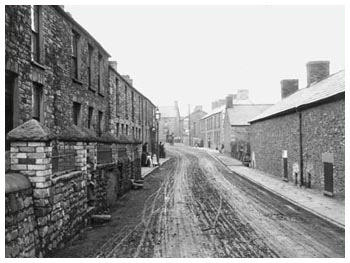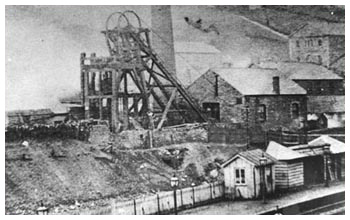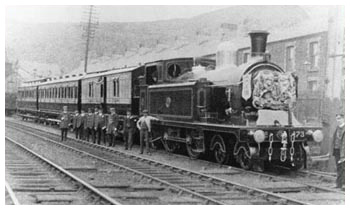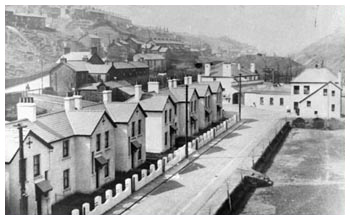
| Dinas | |
| The name Dinas today denotes a city, but its original meaning more closely denotes a ‘hill fort', and on Craig Y Ddinas, the hillside above Dinas, ancient remains suggesting such a structure were discovered. Additionally in the early nineteenth century the expansion of mining in the area led it to become known colloquially as ‘Dinas Y Glo', or ‘The Coal City'. Right: Dinas Ishaf Farm |
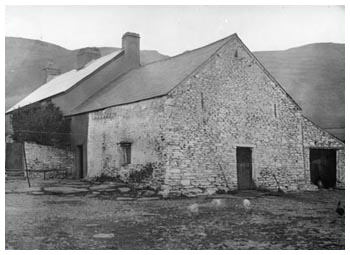 |
The village of Dinas has a very special place in any history of the Rhondda for it is here that the birth of the coal industry in the valley, and hence the birth of industrial Rhondda itself, can truly be said to have taken place. This development began when Walter Coffin, a businessman from Bridgend, bought Dinas farm in the early 1800's, followed subsequently by the mineral rights to Gwaun Ddu and Gwaun Adda Farms, with the intention of prospecting the area for coal. The early days of mining in Dinas were beset by problems as the science of geology was at that time in its infancy, and the extent of the coal measures on the land unproved. Also the Rhondda at that time was bereft of manpower with experience of the mining industry, meaning skilled labour had to be imported and housed in the area. |
|
Above: Cymmer Road Dinas |
The early development of Dinas can be seen on the 1847 tithe map of the area. This shows a clear contrast to the majority of the Rhondda at that time, which mainly consisted of scattered farmhouses and the odd cottage, chapel or church. Dinas however shows the beginning of the Rhondda's first ‘true' mining community, with the first rows of cottages built by and owned by Coffin to house his workers, as well as cottages owned by David Griffiths, also housing Coffin's workers. Additionally the map shows a chapel with a graveyard and house attached, Dinas' first chapel ‘Ebenezer' was built in 1830. |
By the 1930's these early workers were supplemented by a number of agricultural labourers from the Vale of Glamorgan. Although the extent of Coffin's mining operations were small by later standards, it was his pioneering vision that was to provide the catalyst for the later wholesale coal mining of the area that was to change the face of the Rhondda for ever. |
Dinas Colliery |
| DINAS MINES RESCUE STATION | |
Royal train at Porth carrying George V who opened the Mines Rescue Station at Dinas 1912 |
Coal mining has always been a dangerous occupation, as well as big disasters which claimed the lives of large numbers of men and boys many miners were killed through rock falls, shaft accidents, dram accidents etc. As such between 1889 and 1910 there were an average of over 1,000 mining deaths every year in Britain, a figure that reached over 1,800 in 1910. This led to the British Government passing the Coal Mines Act of 1911. Among the provisions of this Act was for the setting up by the mine owners of Central Rescue Stations whereby all mines included in the provisions of the Act had to be within ten miles of such a station. |
| This Association represented more than twenty mining companies in the Rhondda and surrounding area, which in turn owned more than seventy collieries. The site of the Rescue station was chosen at Dinas, coincidentally less than 200 yards from the site of the first shaft sunk in the Rhondda by Walter Coffin, which allowed easy access to both the Rhondda Fach and Rhondda Fawr valleys. Messrs. Niblett and Davies of Cardiff erected the building at a cost of nearly three and a half thousand pounds. The opening ceremony took place on the 27th June 1912 and was attended by King George V and Queen Mary. | |
Despite the decline of coal mining in the Rhondda in the twentieth century Dinas Rescue Station continued to thrive. It served as a base station to the other rescue stations in South Wales, and as other stations began to close it expanded its coverage to other areas. In its first seventy-five years of operation the Dinas Mines rescue Station trained some 2,000-rescue men and attended over 200 emergency calls in the process saving countless miners lives. Right: The Rescue Station - Dinas |
|
| Today the Mines Rescue Station at Dinas continues to provide a valuable service to the community. Following the privatisation of the mining industry in the 1980s Dinas has been run by a private company, Mines Rescue Service Ltd. As well as continuing its expert rescue function, the station at Dinas also offers training to private companies, organisations and individuals in areas such as first aid, breathing apparatus, health and safety, amongst others. | |
